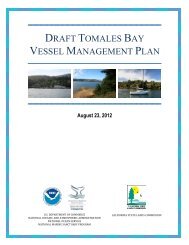Symposium program - Gulf of the Farallones National Marine ...
Symposium program - Gulf of the Farallones National Marine ...
Symposium program - Gulf of the Farallones National Marine ...
You also want an ePaper? Increase the reach of your titles
YUMPU automatically turns print PDFs into web optimized ePapers that Google loves.
As a top predator, white sharks () occupy one <strong>of</strong> <strong>the</strong> highest levels in <strong>the</strong> oceanic food web giving this species<br />
great potential for biomagnification <strong>of</strong> organochlorines (OCs). Liver and muscle (red and white) samples<br />
from incidentally caught young-<strong>of</strong>-year (YOY) and juvenile white sharks were analyzed for organochlorines<br />
(polychlorinated biphenyls, DDT, HCHs, hexachlorobenzene and chlordanes). OC concentrations were <strong>the</strong><br />
highest in liver samples (n = 16) with total DDT (∑DDT) Having <strong>the</strong> highest levels <strong>of</strong> all <strong>the</strong> OCs (68.31 + 70.98<br />
µg/g, lipid weight (lw); mean + SD), followed by total PCBs (∑PCBs; 17.94 + 11.67 µg/g, lw) and total CHLs<br />
(∑CHL; 1.51 + 0.79 µg/g, lw). These are <strong>the</strong> highest levels <strong>of</strong> OCs reported in elasmobranchs to our knowledge.<br />
Average white shark DDT:PCB ratio ranged from 3.62 to 6.59 indicating that <strong>the</strong>y accumulate higher DDT<br />
loads than PCBs, which corresponds to <strong>the</strong> DDT signature found in <strong>the</strong> SCB. YOYs feed heavily on benthic<br />
fishes, which may come from contaminated areas, but it is unlikely <strong>the</strong>y could accumulate pollutant loads <strong>of</strong> this<br />
magnitude solely from <strong>the</strong>ir diet. Pinnipeds in <strong>the</strong> SCB have also been found to have high contaminant loads and<br />
high DDT to PCB ratios (6.87) in <strong>the</strong>ir blubber. Since adult white sharks are known to feed on SCB pinnipeds,<br />
it is possible that high DDT:PCB ratios observed in young-<strong>of</strong>-<strong>the</strong>-year white sharks are attributed to maternal<br />
<strong>of</strong>floading on <strong>the</strong>se contaminants to <strong>the</strong>ir <strong>of</strong>fspring. Despite <strong>the</strong> high level <strong>of</strong> contaminants found in YOY white<br />
sharks, nothing is known about <strong>the</strong> long-term physiological effects or impacts to growth and survivorship.<br />
Ramón Bonfil 1, 2<br />
, José L.. Castillo-Geniz 3 , Oscar Sosa-Nishizaki 4 , Shannon O’Brien 5 , Barbara Mangold 6 , Arturo<br />
Carmona-Torres 4<br />
1<br />
2233 Caton Ave, 5C, Brooklyn NY, 11226<br />
2<br />
NABU, Naturschutzbund Deutschland e.V., Leif Miller, Invalidenstraße 112, 10115, Berlin, Germany<br />
3<br />
INAPESCA, CRIP Ensenada, El Sauzal de Rodriguez, B.C., Mexico<br />
4<br />
Departamento de Oceanografia, CICESE. Ensenada B.C., Mexico<br />
5<br />
School <strong>of</strong> Fisheries, University <strong>of</strong> Washington. Seattle, WA<br />
Real-Time Tracking <strong>of</strong> Migrating Adult White Shark, Carcharodon carcharias<br />
from Guadalupe Island, Mexico<br />
Despite recent advances in electronic tagging, real-time tracks <strong>of</strong> migrating great white sharks, Carcharodon<br />
carcharias, remain rare. Due to <strong>the</strong> difficulty and risk <strong>of</strong> deploying real-time satellite transmitters on live sharks,<br />
previous studies have only acquired data from juvenile white sharks. Here we report on <strong>the</strong> first real-time satellite<br />
tracking <strong>of</strong> a great white shark in <strong>the</strong> North Pacific Ocean. A 5.1 m total length adult female Carcharodon<br />
carcharias was tagged with a SPOT tag in Guadalupe Island, Baja California, Mexico on October 16, 2006. This<br />
shark was intermittently tracked for a total <strong>of</strong> 288 days and a grand total <strong>of</strong> 7,100 km. The shark remained in<br />
<strong>the</strong> vicinity <strong>of</strong> <strong>the</strong> tagging site, <strong>the</strong> NE coast <strong>of</strong> Guadalupe Island, for a few days after tagging. For <strong>the</strong> next three<br />
and a half months <strong>the</strong> shark moved between <strong>the</strong> east and west coasts <strong>of</strong> <strong>the</strong> island, but spent significantly more<br />
time <strong>of</strong>f <strong>the</strong> north east coast. At <strong>the</strong> beginning <strong>of</strong> February, <strong>the</strong> shark moved suddenly and decisively away from<br />
Guadalupe Island to embark on a ca. 3,900 km westward migration. This clear directional movement took <strong>the</strong><br />
adult female on an arc-shaped route to a distinct region nor<strong>the</strong>ast <strong>of</strong> <strong>the</strong> Hawaiian Islands. During <strong>the</strong> next four<br />
months <strong>the</strong> shark roamed an adjacent ca. 600 km-wide region following a bee-line pattern. The latter area <strong>of</strong> <strong>the</strong><br />
North Pacific to where this adult female moved is previously unknown as a focal area for this species. Time at<br />
temperature data were intermittently transmitted by <strong>the</strong> tag and are also presented.<br />
Russell W. Bradford and Barry D. Bruce<br />
CSIRO <strong>Marine</strong> and Atmospheric Research, GPO Box 1538. Hobart Tasmania 7008. Australia<br />
Identifying juvenile white shark behaviour from electronic tag data<br />
Juvenile white sharks (1.7 - 2.8 m) are seasonally resident in <strong>the</strong> Port Stephens area <strong>of</strong> central NSW from mid<br />
August to early January, one <strong>of</strong> only two known nursery areas for <strong>the</strong> species in eastern Australia. Sharks reside<br />
at a second known nursery area in coastal waters <strong>of</strong> eastern Bass Strait, 900 km south, from January to April and<br />
return north during <strong>the</strong> May-June period. When resident at <strong>the</strong> Port Stephens site, sharks are highly visible in<br />
<strong>the</strong> near-shore surf zone where interactions with recreational fishers and beach users are frequently reported.<br />
We used data from <strong>the</strong> deployment <strong>of</strong> 20 SPLASH and 7 PSAT tags (6 <strong>of</strong> which were returned for full data<br />
download) on 25 JWS to identify <strong>the</strong> spatial extent <strong>of</strong> <strong>the</strong> Port Stephens aggregation and <strong>the</strong>ir behaviour. The<br />
Port Stephens nursery area is highly focussed along a 60 km stretch <strong>of</strong> coastline with sharks occupying areas<br />
from <strong>the</strong> near-shore surf zone out to adjacent waters <strong>of</strong> <strong>the</strong> mid-shelf in depths <strong>of</strong> 120 - 140 m waters, 10-15<br />
km from shore and covering a geographic area <strong>of</strong> approximately 1000 sq km. We used Mean First Depth (MFD)<br />
analyses to define behavioural signatures and provide an indication <strong>of</strong> habitat use when sharks were resident at,







